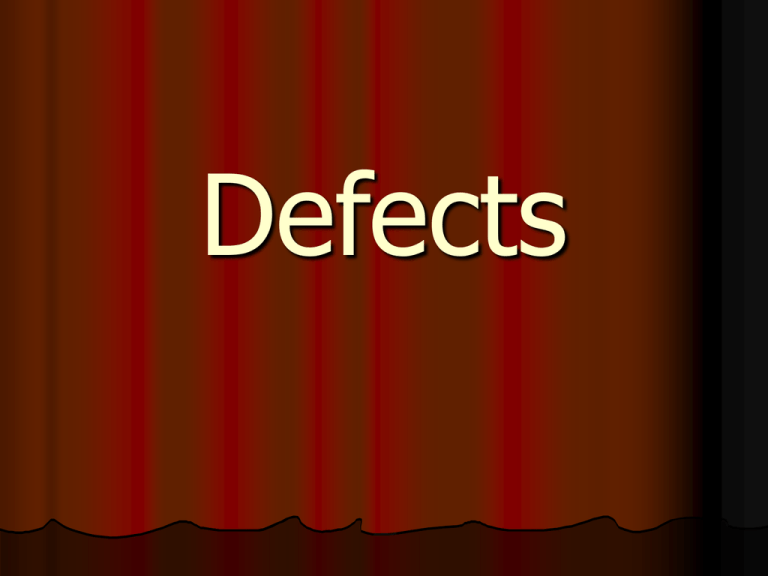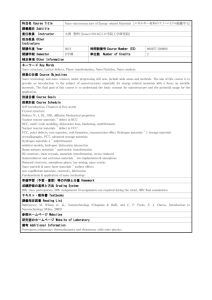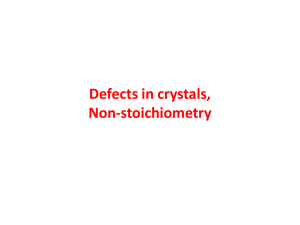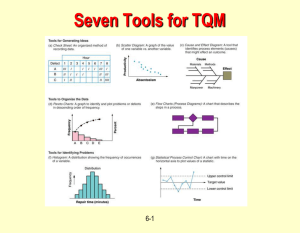1. dia
advertisement

Defects
Types of defects
Structures of the solids considered have
been ideal, i.e. devoid of defects.
Real materials contain structural defects
which can dominate their physical and
chemical behaviour.
?
Disordered?
Definition:
A structural defect is thus a
configuration in which an atom, or
group of atoms does not satisfy the
structural rules belonging to the
ideal reference state of the
materials.
There are many different types of structural
defects. Defects are spatially localized in some way,
i.e. defects are structurally inhomogeneous.
Zero-dimensional (point) defects:
An atom may be missing from a lattice
site, thereby forming an atomic
vacancy.
Another type of atom may be present at a
lattice site, forming a substitutional
impurity defect.
An atom may be situated at an
interstritial site between lattice sites.
One-dimensional (line) defects
Translational
displacements
of atoms
(dislocations).
Rotational displacements (disclinations).
Two dimensional (planar) defects
Low angle grain boundary
V-shaped crystals in CVD prepared diamond film grown on Si
substrate
P.B. Barna
Amorphous cases?
Types of defects?
Dangling bond (positive U)
It is simple a broken or unsatisfied bond
in a covalent solid. A simple dangling bond
normally contains one electron and
electrically neutral. But! Under certain
circumstances the electronic occupancy
can change!
(U is Hubbard energy; electron-electron
interaction)
In amorphous silicon the atoms form a
continuous random network. Not all the
atoms within amorphous silicon are
fourfold coordinated. Some atoms have a
dangling bond. These dangling bonds are
defects in the continuous random
network, which cause anomalous electrical
behavior.
Dangling bond (DB) has ESR signal!
D0; D+; D-
Avoid DB
If desired, the material can be passivated
by hydrogen, which bonds to the dangling
bonds and can reduce the dangling bond
density by several orders of magnitude.
Hydrogenated amorphous silicon (a-Si:H)
has a sufficiently low amount of defects to
be used within devices.
Dangling bond (negative U)
VI. column elements:
a. End of chains, one coordinated atoms.
b. Junction, three-fold coordinated atoms.
No ESR signal. Electron-Phonon
interaction
Coordination defects
Wrong bonds
A-A, B-B bonds in AB alloys instead of A-B
bonds
Electrical
conductivity
General aspects
Electrical conduction of amorphous
semiconductors consists of :
1. band conduction
2. hopping conduction
1. Band conduction
(electron and hole)
Band conduction in undoped amorphous
semiconductor characterized by
б=бo exp { - Ea / kbT}
where б and бo are electrical conductivity
and a prefactor. Ea, kb and T are the
activation energy, the Boltzmann constant
and temperature.
2. Hopping conductivity
a./ nearest-neighbour hopping
Nearest neighbour hopping is well known
in crystalline semiconductors, in which
electrons hop the nearest-neighbouring
sites by emitting or absorbing phonons in
n-type (p-type) semiconductors.
b./ variable-range hopping
Variable-range hopping is particularly
associated with tail states, in which
electrons or holes in tail states hop to the
most probable sites. This type of hopping
conductivity is characterized by
temperature variation as follows:
бp=бpo exp { - B/ T1/4}







